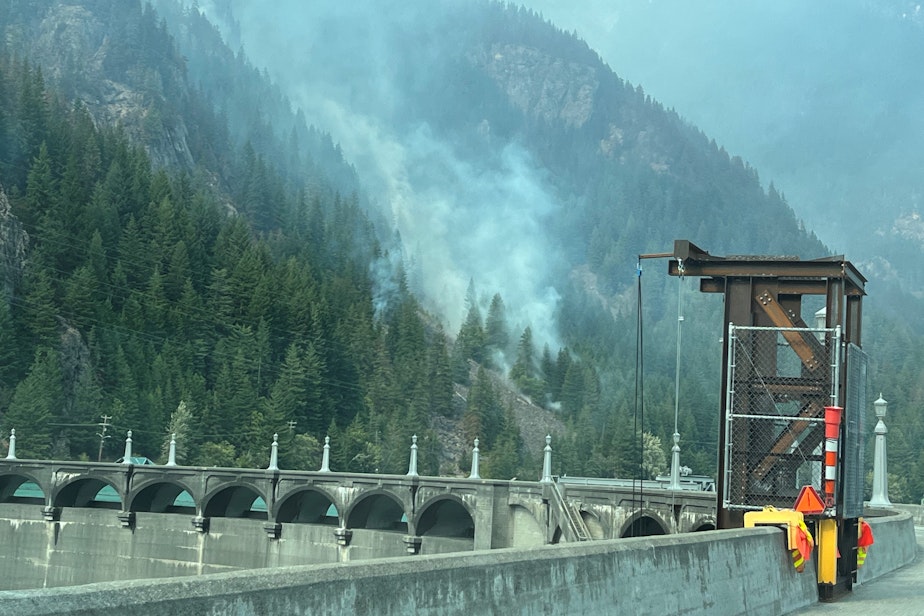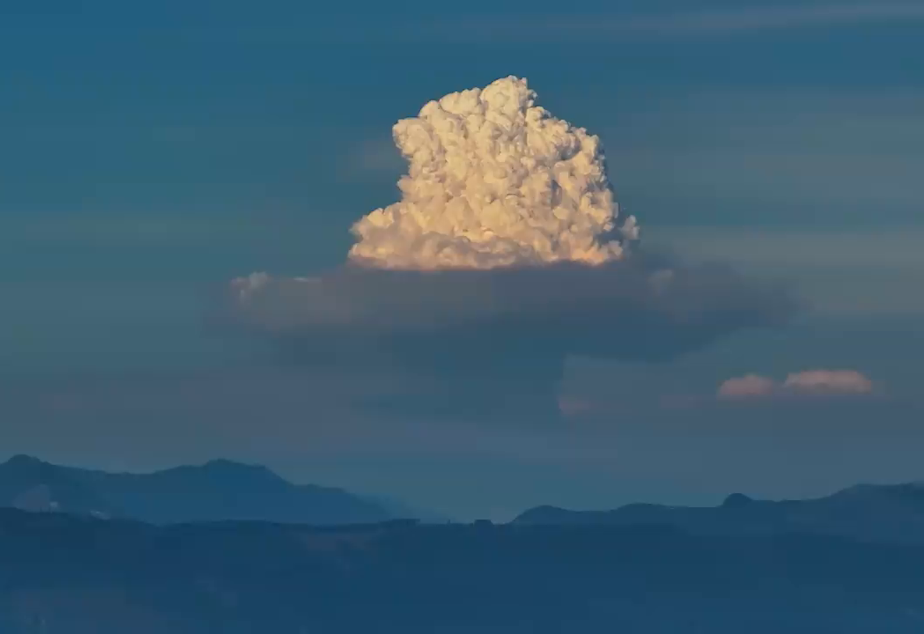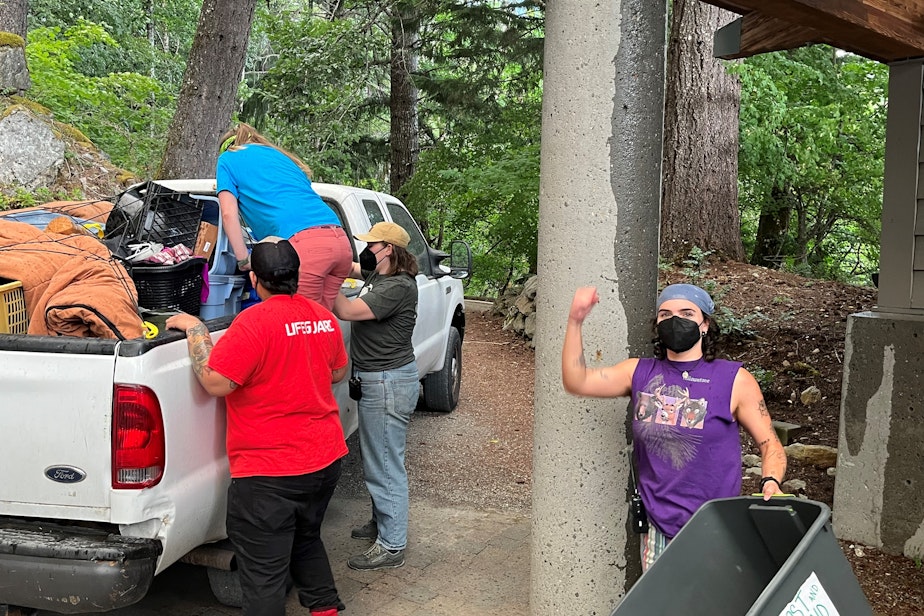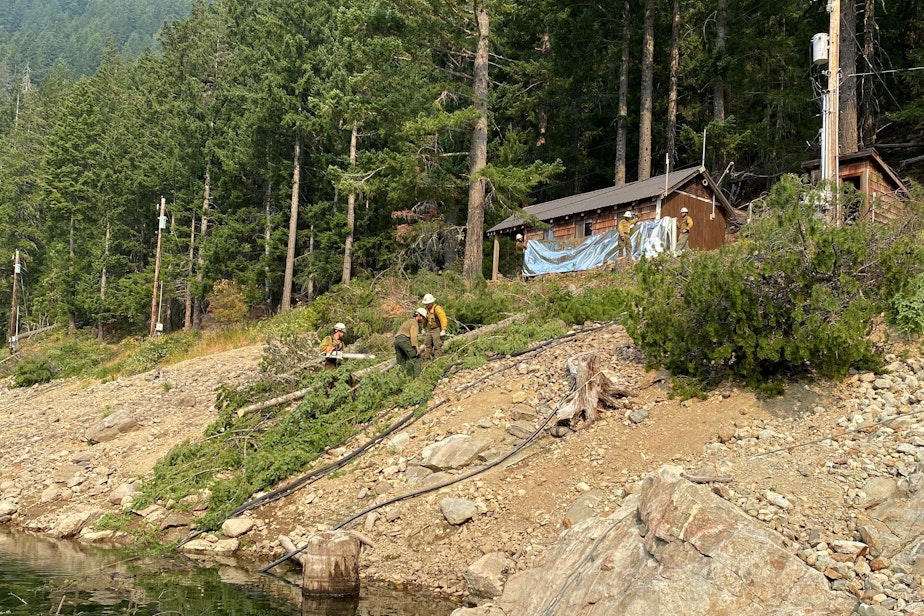Sourdough Fire takes bite out of Seattle’s electricity supplies

Seattle’s power utility has had to cut energy production at its Skagit River dams in half as the Sourdough Fire has forced workers at one of Seattle’s main energy sources to evacuate.
More than 300 firefighters are battling the wildfire near Seattle City Light’s Diablo, Ross, and Gorge dams in Washington’s North Cascades. Those Skagit River dams provide up to a third of Seattle's electricity.
“It's gotten very close to both Diablo Dam and our Diablo powerhouse,” said Andrew Strong, who is in charge of power generation and engineering at Seattle City Light. The utility evacuated 15 employees and family members living at the tiny company town of Diablo.
“We made a decision to evacuate the immediate area, which meant curtailing generation was the best course of action,” Strong said.
Seattle City Light has taken its Diablo and Ross dams offline, while the Gorge Dam—at about 4 miles downriver from Diablo Dam, the closest of the three dams to Seattle—is continuing to help power the city.
The two upper dams are still generating some power locally but are no longer sending electricity along the major transmission lines that connect the dams to the power outlets of the Seattle area.
Sponsored
Firefighters and City Light crews have been clearing vegetation around those transmission lines to protect them.
Strong said even wildfire smoke can damage transmission lines.
“It can cause unintended arcing between adjacent lines,” Strong said. “Much as a tree branch might contact two different lines, smoke can affect systems similarly.”
City light officials say they’ve boosted hydropower production at Boundary Dam in the state’s northeast corner and purchased more wind, solar, and hydropower to fill the gap left by the Skagit dams.
Cool, humid conditions Monday slowed the fire’s growth. Officials estimated its size at 1,440 acres, up from 30 acres on Thursday.
Sponsored
On Friday, the rapidly growing fire sent a billowing pyrocumulus cloud—visible 100 miles away—into the upper atmosphere. The expanding blaze led state transportation officials to close Highway 20 across the North Cascades that night. It remains closed.

 1 min
A time-lapse video of a pyrocumulus cloud billowing thousands of feet above Washington's Sourdough Fire on Aug. 4, 2023, from 5:24 p.m. to 6:00 p.m., filmed from a drone above Camano Island, 72 miles away.
1 min
A time-lapse video of a pyrocumulus cloud billowing thousands of feet above Washington's Sourdough Fire on Aug. 4, 2023, from 5:24 p.m. to 6:00 p.m., filmed from a drone above Camano Island, 72 miles away.
With the Sourdough Fire overtaking some of Washington’s most rugged topography, fire crews have been focused on protecting buildings and valuable infrastructure to the fire’s south and mostly letting flames spread north into the deep wilderness of North Cascades National Park.
“The fire management team has extensive hosing and sprinkler systems all around the structures, and they are keeping some of the vegetation wet,” said Jodi Broughton with the North Cascades Institute. The nonprofit group operates the North Cascades Environmental Learning Center on the north shore of Diablo Lake reservoir.
Sixteen of the center’s staff members were evacuated from the residential campus. All classes have been canceled through Aug. 21.

Sponsored
“Some of our staff members were allowed back in by the fire management team [on Sunday], and they organized a group to go up and get some of their personal belongings and some of our institute materials,” Broughton said.
Last fall, wildfire smoke forced the learning center to cancel five weeks of its classes for fifth graders.
“As we know with climate change, we are seeing more fires, and they tend to get out of control more quickly,” Broughton said. “It's always disconcerting when something happens so close to where people are living and working.”
Diablo Dam has received 3 inches of rain since May 1, less than half its 30-year average, according to data provided by Washington state climatologist Nick Bond.
“The last 3 months at that location have been quite dry and warm,” Bond said by email.
At the Ross Lake Resort, firefighting crews towed its floating cabins into the middle of the mountain-ringed reservoir known as Ross Lake. The resort is built from the remains of a floating camp used by workers logging the valley as it was flooded in 1952.

Sponsored
Crews wrapped other cabins at the resort with five-foot-wide sheets of aluminum-fiberglass foil, a strategy also used to shield the Sourdough Mountain Lookout high above Ross Lake. The lookout, a 14-foot-by-14-foot one-room cabin, was built in 1933 by the Civilian Conservation Corps and is on the National Register of Historic Places.
“It's wrapped with tin foil, sort of like a big potato,” said Mark Enty, a spokesperson for the fire incident command. “That should basically be the last line of defense to protect that structure from radiating heat.”
Poet Gary Snyder spent a summer as a U.S. Forest Service lookout there in 1953, the year after Ross Lake flooded the upper Skagit valley to the Canadian border. He penned poems including "Mid-August at Sourdough Mountain Lookout," which concludes:
Drinking cold snow-water from a tin cup
Looking down for miles
Sponsored
Through high still air.
Snyder descended from the lookout on Aug. 30, 1953, with the first snow.
In 2023, fire officials say the Sourdough Fire might not be extinguished until autumn rain or snow return to the North Cascades, with an expected date of Oct. 1.




